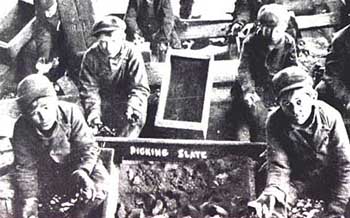Activity 2
Essential Question
- How were lives of children impacted by the industrial revolution?
Background
In the 1800s many children as young as nine or ten years old worked at full-time jobs in factories and coal mines. Often the work was hard and dangerous, and the children worked as long as twelve hours a day. Usually, the children went to work because they had to help support their families. Many people including their parents knew that these children should be in school, but economic necessity forced them to allow these abuses to continue.

-edited from http://www.dol.gov
Instructional Strategies
Strategy 1 |
Computer Activity/Using Pictures to Teach Social Studies
Use this website or one like it to do this activity: http://www.historyplace.com/unitedstates/childlabor/
Have the students first use their textbooks to find pictures of children in the workplace during this time period. Ask them how they would feel if they were working in similar conditions. Relate the pictures to the previous role-play situation.
Use the computers in your room or take the class to the computer lab. Have the students pull up the website and use a graphic organizer to compare and contrast the pictures that they see on this website
- What similarities do they see in the pictures?
- What differences do they see in the pictures?
A Venn Diagram would be useful for this activity.
Use the four questions that follow both as purpose questions for viewing the pictures and as small group discussion questions.
- What conditions made child labor a problem both in Great Britain and in the United States?
- How could pictures such as these lead to the passing of child labor laws?
- If you were a judge prior to 1930, would you be in favor of child labor laws or would you think that this was limiting the “personal freedom” of children to work? Would it limit the rights of factory and mine workers? If you said yes, explain in what way it would limit rights?
- Why does child labor remain a serious problem in many parts of the world despite the efforts of many people to combat it?
Check for Understanding
Ask the students to select one of the questions and to give a written response to it. Use the points brought up in the discussion as the basis for scoring the writing activity.
Strategy 2 |
Graphic Organizers
Use a graphic organizer (a Venn Diagram or a Comparison/Contrast Chart would work well) to help students make connections between what happened in Great Britain and United States and what is happening in third world countries today. Give the groups the opportunity to discuss the last two pictures. Have them look for similarities and differences and record them on a graphic organizer on a transparency. Share the Venn Diagrams with the entire class and encourage students to provide support for their conclusions.
Strategy 3 |
Problem-Solving Process
In small groups, have the students use a problem-solving process to suggest a tentative solution to the problem of child labor in third world countries. Ask them to call upon prior knowledge to:
- Tell why there is a need for a solution to the problem
- List some possible solutions to the problem
- Think about the positive and negative consequences of each solution
- Choose the best solution and be prepared to defend the solution
Have the students keep this information in their notebooks for future reference in completing the performance assessment for this module



